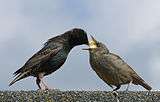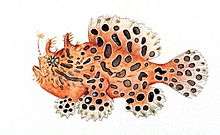Lepidophagy
Lepidophagy is a specialised feeding behaviour in fish that involves eating of scales of other fish.[1] Lepidophagy is widespread, having been independently evolved in at least five freshwater families and seven marine families.[2] A related feeding behavior is pterygophagy, which are fish that feed on the fins of other fish.[3]

Species
Lepidophagy or scale-eating has been reported in a range of fish including: Chanda nama (family Ambassidae),[4] Plagiotremus (family Blenniidae),[5] Terapon jarbua (family Terapontidae),[1] a few Ariopsis and Neoarius species (family Ariidae),[6] several pencil catfish (family Trichomycteridae),[5] some piranha, Exodon paradoxus, Probolodus, Roeboides and Roeboexodon species (order Characiformes),[2][7][8][9] Cyprinodon desquamator (family Cyprinodontidae), along with both Perissodus species, all four Plecodus species, Xenochromis, Haplochromis welcommei, Docimodus, Corematodus and Genyochromis mento (family Cichlidae from the African Great Lakes).[10][11][12]
Several of these scale-eaters will also feed on fins of other fish and many omnivorous or predatory fish may on occasion nip the fins of other fish. Only a few are specialized fin-eaters or pterygophagous, notably Belonophago, Eugnathichthys and Phago (family Distichodontidae), Aspidontus (family Blenniidae), and Smilosicyopus (family Gobiidae).[3][13] A somewhat related behavior is found in Magosternarchus, which feed on the tails (both fin and connective tissue) of other gymnotiform knifefish.[14]
Physiology
Many species of cichlid fish have evolved structural changes to their teeth and mouth, which makes them better able to feed on the scales of other fish.[15] Other species of fish have morphology that is better adapted to scale-eating behaviour. Many of their oral structures closely resemble each other even throughout different environments but many also have specialized modifications in their jaw structure.[16] One specific species of fish, called Roeboides prognathous, has an extremely specialized jaw structure for supporting their lepidophagous behaviour.[16] Certain species of lepidophagous catfish, Pachypterus khavalchor, have digestive enzymes which help them more readily break down the fins, eyes, scales of other fish.[16] There are other morphological structures that are important in scale eating habit. There are six lepidophagous cichlid species who employ aggressive mimicry strategies on their prey. The colors of the cichlid fish immensely resemble their prey but these cichlid species do not only eat the scales of the fish it resembles, but they prey on a wide range of species.[15]
Behaviour
There are many different behaviours associated within lepidophagous fish. Aggression and attack behaviours like chasing and striking prey are common among Pachypterus khavalchor catfish, who then eat the fallen scales of their prey.[16] Attack behaviours for the wimple piranha Catoprion mento, whose diet consists of mainly scales, is explained as a high speed attack. They ram into their prey with their mouth open, biting the prey to obtain their scales.[17] Perissodus microlepis cichlid fish tears off the scales of their prey as they swim past.[18]
This is a very different than other lepidophagous species who just knock the scales loose by striking the prey.[17]
There are differences and similarities in lepidophagous behaviours among different species and within similar species. For example, The siluroid catfish attacking behaviour is similar to the Probolodus heterostomus since they both attack their prey from behind and they also follow their prey. This is dissimilar to Roeboides prognatus and Exodon paradoxus who remove scales more easily by attacking a specific area called the caudal area.[16] Moreover, there has been many studies done on the hunting behaviours of scale-eating fish and how those behaviours have evolved over time. Certain species of cichlid aggressively mimic the behaviours of their prey.[15] This is a behaviour that is rarely seen in other scale eating fish.[15]
Niche
The differences in the niche of certain species may play a role in their behaviours. Lepidophagous behaviours only exist in some species.[19] Adaptive radiation has been mentioned in many articles as having a role in the evolution of lepidophagy.[19] There is some evidence to support this but much is also unclear. Some behaviours in certain species of fish support the theory that extreme environments could be potential causes of scale eating behaviours. Some of those species are named below.
Cyprinodon pupfish
In the case of Cyprinodon pupfish, almost all have a diet of algae and detritus but the species Cyprinodon desquamator (only scientifically described in 2013; previously known as Cyprinodon sp. "lepidophage" or Cyprinodon sp. "scale-earter") is different. There are only two known cases where several Cyprinodon species live together: lakes in San Salvador Island, the Bahamas, and Lake Chichancanab, Mexico. In both cases, the co-occurring Cyprinodon species have diverged into feeding on different things and in lakes on San Salvador Island, this includes the scale-eating C. desquamator (there are no scale-eaters in Lake Chichancanab, although C. maya has become a fish-eater).[20]
Cichlids
There is a diverse range of cichilds in Lake Tanganyika in East Africa but the Tanganyikan cichlid tribes, Perissodini and Plecodus, feed on the scales of cichlids and fish.[21] Other species of cichilds, Petrochromis, feed on algae and plants and live in rocky parts or the lake where they can graze on algae. The species of cichilds that exhibit scale eating behaviours live in deep water with very low levels of oxygen and have had to rapidly evolve to keep up with a changing environment and lack of food.[19]
Trade-offs
Fish scales are a surprisingly nutritional food source, containing layers of keratin and enamel, as well as a dermal portion and a layer of protein-rich mucus. They are a rich source of calcium phosphate.[2] However, the energy expended to make a strike versus the amount of scales consumed per strike puts a limit on the size of the lepidophage; such fish seldom exceed 20 cm (8 in) and most are under 12 cm (5 in).[2] Because of this lepidophagous fish usually are much smaller than their prey. Though scales are nutritious, the average amount of scales dislodged and eaten may not be sufficient to make up for the energy lost during the attack.[17] The attack behaviours and strikes that are employed to remove and eat scales have an energy cost and risk of harm to the predator.[22] In light of this, there are also a number of advantages to consuming scales: scales are common, covering the body of most fish species, can be regrown relatively quickly by "prey" fish, are abundant and seasonally reliable, and their removal requires specific behaviours or morphological structures.[2] Scale eating behaviour usually evolves because of lack of food and extreme environmental conditions. The eating of scales and the skin surrounding the scales provides protein rich nutrients that may not be available elsewhere in the niche.[20]
References
- Froese, R. and D. Pauly. Editors. "Glossary: Lepidophagy". FishBase. Retrieved 2007-04-12.
- Janovetz, Jeff (2005). "Functional morphology of feeding in the scale-eating specialist Catoprion mento" (PDF). The Journal of Experimental Biology. 208 (Pt 24): 4757–4768. doi:10.1242/jeb.01938. PMID 16326957.
- Lavoué, S.; Rabosky, D.L.; McIntyre, P.B.; Arcila, D.; Vari, R.P.; Nishida, M. (2017). "Trophic evolution in African citharinoid fishes (Teleostei: Characiformes) and the origin of intraordinal pterygophagy". Molecular Phylogenetics and Evolution. 113: 23–32. doi:10.1016/j.ympev.2017.05.001.
- Grubh, A. R.; Winemiller, K. O. (2002). "Ontogeny of Scale Feeding in the Asian Glassfish, Chanda nama (Ambassidae)". Copeia. 2004 (4): 903–907. doi:10.1643/CE-02-095R1.
- Sazima, I. (1983). "Scale-eating in characoids and other fishes". Environmental Biology of Fishes. 9 (2): 87–101. doi:10.1007/BF00690855.
- Szelistowski, W. A. (1989). "Scale-Feeding in Juvenile Marine Catfishes (Pisces: Ariidae)". Copeia. 1989 (2): 517–519. doi:10.2307/1445459. JSTOR 1445459.
- Froese, R. and D. Pauly. Editors. "Exodon paradoxus,Bucktooth tetra". FishBase. Retrieved 2007-04-12.
- Petersen, C. C.; Winemiller, K. O. (1997). "Ontogenic diet shifts and scale-eating in Roeboides dayi, a Neotropical characid". Environmental Biology of Fishes. 49 (1): 111–118. doi:10.1023/A:1007353425275.
- Santos, O.; R.M.C. Castro (2014). "Taxonomy of Probolodus Eigenmann, 1911 (Characiformes: Characidae) with description of two new species, and comments about the phylogenetic relationships and biogeography of the genus". Neotrop. Ichthyol. 12 (2): 403–418. doi:10.1590/1982-0224-20130232.
- Yanagisawa, Y. (1984). "Parental strategy of the cichlid fish Perissodus microlepis, with particular reference to intraspecific brood 'farming out'". Environmental Biology of Fishes. 12 (4): 241–249. doi:10.1007/BF00005455.
- Nshombo, M. (1991). "Occasional egg-eating by the scale-eater Plecodus straeleni (Cichlidae) of Lake Tanganyika". Environmental Biology of Fishes. 31 (2): 207–212. doi:10.1007/BF00001022.
- Konings, A. (1990). Ad Konings' Book of Cichlids and all the other Fishes of Lake Malawi. ISBN 978-0866225274.
- Lu, Y.-T.; Liu, M.-Y.; He, Y.; Liao, T.-Y. (2016). "Smilosicyopus leprurus (Teleostei: Gobiidae) is a Fin-eater". Zoological Studies. 55: 31. doi:10.6620/ZS.2016.55-31.
- Lundberg, J.G., Fernandes, C.C., Albert, J.S. and Garcia, M. (Aug 1, 1996). "Magosternarchus, a New Genus with Two New Species of Electric Fishes (Gymnotiformes: Apteronotidae) from the Amazon River Basin, South America". Copeia. 1996 (3): 657–670. doi:10.2307/1447530. JSTOR 1447530.CS1 maint: multiple names: authors list (link)
- Boileau, Nicolas; Cortesi, Fabio; Egger, Bernd; Muschick, Moritz; Indermaur, Adrian; Theis, Anya; Büscher, Heinz H.; Salzburger, Walter (23 September 2015). "A complex mode of aggressive mimicry in a scale-eating cichlid fish". Biology Letters. 11 (9): 20150521. doi:10.1098/rsbl.2015.0521. PMC 4614428. PMID 26399975.
- Gosavi, Sachin M.; Kharat, Sanjay S.; Kumkar, Pradeep; Navarange, Sushant S. (July 2017). "Interplay between behavior, morphology and physiology supports lepidophagy in the catfish Pachypterus khavalchor' (Siluriformes: Horabagridae)". Zoology. 126: 185–191. doi:10.1016/j.zool.2017.07.003. PMID 29191622.
- Janovetz, J. (15 December 2005). "Functional morphology of feeding in the scale-eating specialist Catoprion mento". Journal of Experimental Biology. 208 (24): 4757–4768. doi:10.1242/jeb.01938. PMID 16326957.
- Takeuchi, Yuichi; Hori, Michio; Tada, Shinya; Oda, Yoichi; Salzburger, Walter (25 January 2016). "Acquisition of Lateralized Predation Behavior Associated with Development of Mouth Asymmetry in a Lake Tanganyika Scale-Eating Cichlid Fish". PLOS One. 11 (1): e0147476. doi:10.1371/journal.pone.0147476. PMC 4726545. PMID 26808293.
- Koblmüller, Stephan; Egger, Bernd; Sturmbauer, Christian; Sefc, Kristina M. (September 2007). "Evolutionary history of Lake Tanganyika's scale-eating cichlid fishes". Molecular Phylogenetics and Evolution. 44 (3): 1295–1305. doi:10.1016/j.ympev.2007.02.010. PMID 17383901.
- Martin, C.; P.C. Wainwright (2011). "Trophic novelty is linked to exceptional rates of morphological diversification in two adaptive radiations of Cyprinodon pupfish". Evolution. 65 (8): 2197–2212. doi:10.1111/j.1558-5646.2011.01294.x. PMID 21790569.
- Nshombo, Muderhwa (June 1991). "Occasional egg-eating by the scale-eater Plecodus straeleni (Cichlidae) of Lake Tanganyika". Environmental Biology of Fishes. 31 (2): 207–212. doi:10.1007/BF00001022.
- Martin, Christopher H.; Wainwright, Peter C. (19 August 2013). "On the Measurement of Ecological Novelty: Scale-Eating Pupfish Are Separated by 168 my from Other Scale-Eating Fishes". PLOS One. 8 (8): e71164. doi:10.1371/journal.pone.0071164. PMC 3747246. PMID 23976994.
Bibliography
- Boileau, N.; Cortesi, F.; Egger, B.; Muschick, M.; Indermaur, A.; Theis, A.; Büscher, H.; Salzburger, W. (2015). "A complex mode of aggressive mimicry in a scale-eating cichlid fish". Biology Letters. 11: 9. doi:10.1098/rsbl.2015.0521. PMC 4614428. PMID 26399975.
- Janovetz, J (2005). "Functional morphology of feeding in the scale-eating specialist Catoprion mento". Journal of Experimental Biology. 208: 4757–4768. doi:10.1242/jeb.01938. PMID 16326957.
- Martin, C.; Wainwright, P. (2013). "On the measurement of ecological novelty: Scale-eating Pupfish are separated by 168 my from other scale-eating fishes". PLOS One. 8: 8. doi:10.1371/journal.pone.0071164. PMC 3747246. PMID 23976994.
- Koblmuller; Egger, B.; Sturmbauer, C.; Sefc, K. (2007). "Evolutionary history of Lake Tanganyika's scale-eating cichlid fishes". Molecular Phylogenetics and Evolution. 44: 1295–1305. doi:10.1016/j.ympev.2007.02.010. PMID 17383901.
- Martin, Christopher H.; Wainwright, Peter C. (2011). "Trophic novelty is linked to exceptional rates of morphological diversification in two adaptive radiations of Cyprinodon Pupfish". Evolution. 65: 2197–2212. doi:10.1111/j.1558-5646.2011.01294.x. PMID 21790569.
- Sachin, M.; Gosavi, Sanjay; Kharat, Kumkar; Sushant, S.; Navarange (2017). "Interplay between behavior, morphology and physiology supports lepidophagy in the catfish Pachypterus khavalchor (Siluriformes: Horabagridae)". Zoology. 126: 185–191. doi:10.1016/j.zool.2017.07.003. PMID 29191622.

